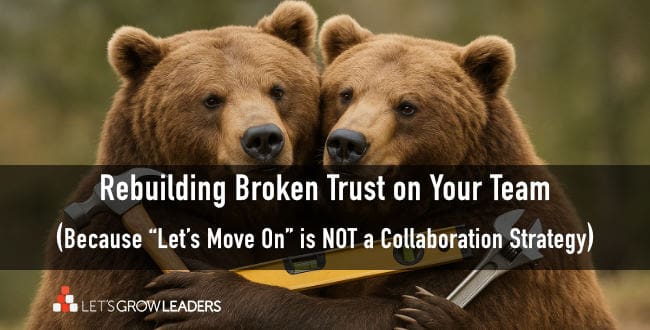Overcoming an Outdated Leadership Brand
Have you ever felt like this? You’ve worked hard to build your leadership brand, but the negative perceptions linger.
You’ve been “all in” to PROVE and IMPROVE yourself as a competent, human-centered leader, but no one can get past the stories… that one time (okay maybe seven times) you lost your cool, stole credit for an idea, or were _________ (insert your frustrating, old reputation here).
You can improve your reputation and your leadership brand with this proactive approach.
What is a leadership brand?
Put simply, your leadership brand is how others would describe you in one sentence.
Imagine a meme or a billboard on the highway describing your leadership. What would it say?
And most importantly, what if that sentence had to include a “But”…
- “She’s a really great person and I love having her on my team, BUT I can’t count on her to meet her commitments.”
- “He’s the best sales guy we have BUT he’s a complete jerk with his internal partners.”
- “She’s smart BUT lacks the confidence to perform at that level.”
- “They have great ideas, BUT lack executive presence.”
When managing your leadership brand, the “buts” matter. If the hard work you’ve done on your “but” isn’t paying off, it might be time to address these perceptions.
7 Steps to Start Changing Perceptions
- Define your aspirational brand
- Ask courageous questions to understand perceptions
- Let others know what you’re working on and why
- Stay consistent and ask for help
- Be interested and generous
- Admit when you screw up
- Don’t give up
1. Define your aspirational leadership brand
Just like with anything else you want to achieve, it’s essential to define what success looks like.
Complete this sentence: “I want to be known for _________. Or, I want to be remembered as a leader who ________.”
For example, we want to be known for practical, sustainable leadership development for human-centered leaders.
Everything we choose to do (or not do) works to enhance or diminish our desired leadership brand. What we want on our “billboard” influences the clients we choose to work with and the commitments we make; the books and articles we write (and read); the guests we invite to our shows; and how we design every leadership development program and keynote speech.
An important part of this aspirational brand exercise is considering what matters in your current culture. Consider the characteristics of the brand you’re building as they relate to the leadership characteristics that are valued and encouraged where you work.
For example, if your aspirational brand is “accountability and results,” and you work in a high-clarity culture with strong expectations and clearly defined goals, that’s a fantastic fit. There’s alignment between how you want to show up and what the culture values.
In contrast, if your leadership brand is “empowering and developing people,” and you work in a churn-and-burn culture, where “no one has time for that stuff,” you’ll have more of a culture-fit issue, than a brand problem.
Next, identify strengths you can build on to enhance the reputation you want. Then look at your biggest opportunities for growth as you build your aspirational leadership brand.
2. Ask courageous questions to understand perceptions
Once you know how you want to show up, the next step is to ask people for their honest perceptions of your leadership brand.
If you’ve got a big but, it’s better to know.
It’s helpful to ask these specific, humble courageous questions in pairs… one strength to build on, and one opportunity to improve. For example,
- What’s one behavior that you think helps my success as a leader? And, what’s one that undermines my success?
- What is one way my current leadership style positively impacts the team? And, what’s one way my current leadership style gets in the way?
3. Let others know what you’re working on and why
It takes time to change perceptions. If you let people know what you’re working on and why it matters, they’re more likely to notice your change in behavior.
Here’s a quick (90-second) excerpt from our interview with Marshall Goldsmith, world-renowned executive coach and author/editor of forty leadership books. You can also watch a longer version here.
He explains how people see our behavior in a way that’s consistent with their previous experience of you, and they look for behavior to reinforce that image. When you let people know you are working on a change, you set them up to better see it.
4. Stay consistent and ask for help
An additional benefit of letting people know you’re working on a behavior change (even if you think you’ve already changed it), is that you can ask for help.
You might say, “I’d really appreciate you looking out for when I do __________. Can you please notice when you see me doing this well, or struggling with it?”
5. Be interested and generous
One big mistake that can damage your leadership brand is to appear too needy or overly focused on your own career. It’s good to ask for help – and it’s equally vital to show up interested and generous to support them.
Avoid “I’ll help you if you help me,” approaches.
Being known as a genuinely interested, supportive leader who cares about others and shows up consistently helpful will help your leadership brand, and build trust while you work on the other aspects of your leadership and reputation.
In our leadership brand workshops, we call this “land in the and:” Be an interesting expert AND an interested connector.
6. Admit when you screw up
“I’m sorry, I really screwed this up,” are powerful words when working to build trust. Don’t hide it or pretend the slip didn’t happen. Your team already knows when you make a mistake or slip back into an undesired behavior.
A quick, sincere apology goes a long way in building your trusted leadership brand.
See Also: How to Give Your Boss Bad News.
7. Don’t give up
Changing negative perceptions take time. Stay focused on consistently doing the right thing. Even if you can’t turn around your damaged reputation in your current situation, the investment in your leadership brand will serve you well, no matter what you do next.
Related Articles on Managing Your Leadership Brand
Executive Presence in a Virtual World: What Matters Now
Managerial Courage: 7 Practical Ways to Be a Bit More Daring
Your turn.
What advice do you have for someone looking to overcome an outdated reputation or negative leadership brand?







0 Comments